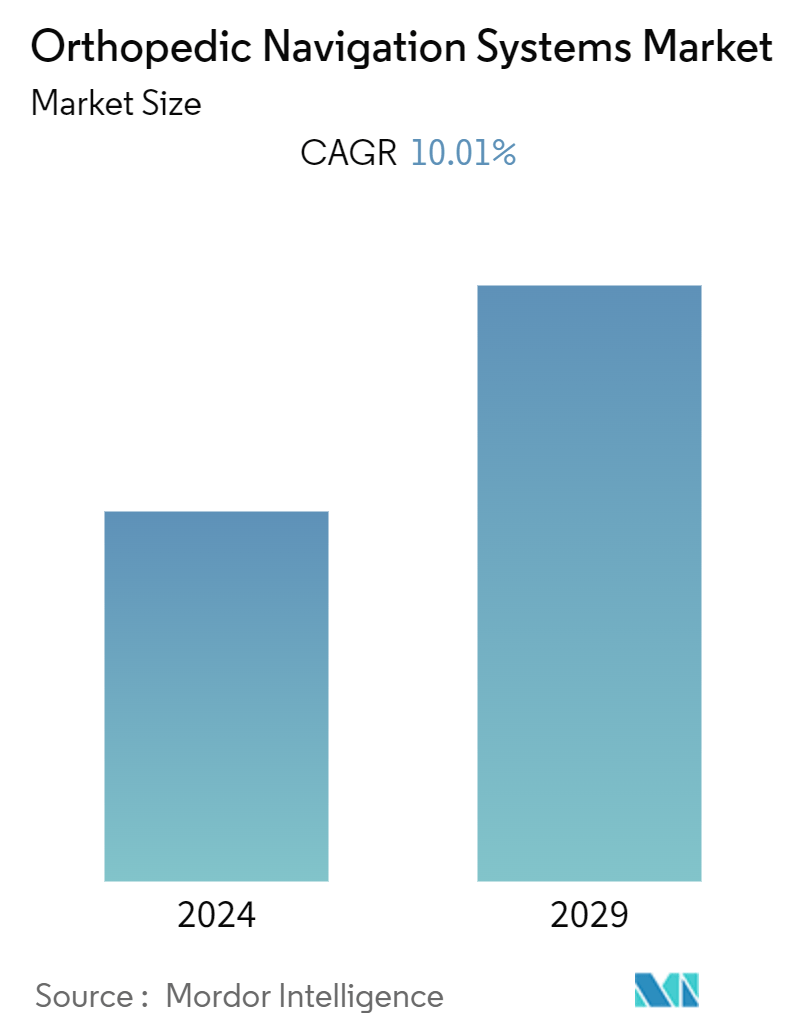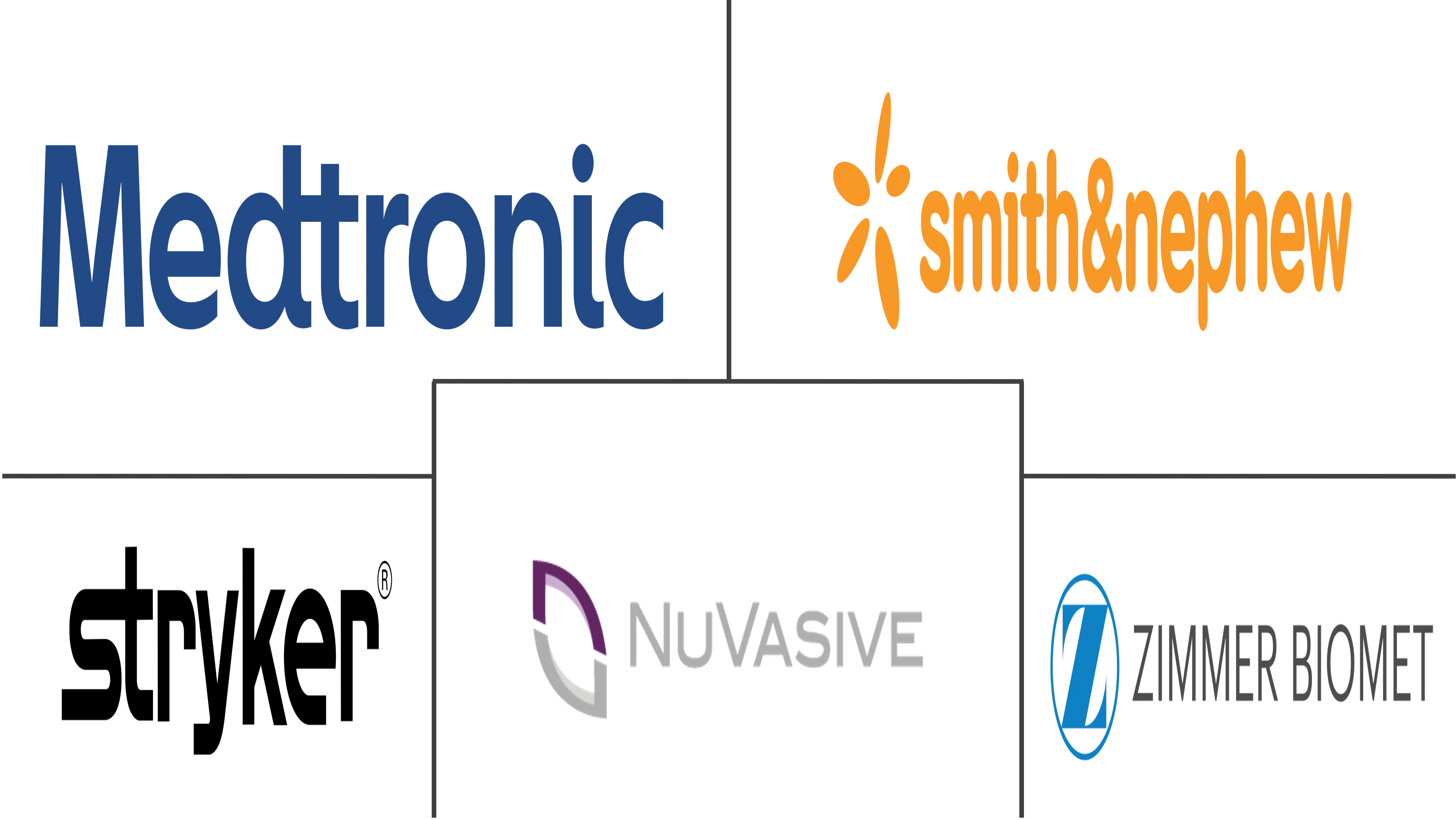Market Size of Orthopedic Navigation Systems Industry

| Study Period | 2019 - 2029 |
| Base Year For Estimation | 2023 |
| Forecast Data Period | 2024 - 2029 |
| CAGR (2024 - 2029) | 10.01 % |
| Fastest Growing Market | Asia-Pacific |
| Largest Market | North America |
Major Players
*Disclaimer: Major Players sorted in no particular order |
Orthopedic Navigation Systems Market Analysis
The Orthopedic Navigation Systems Market is expected to register a CAGR of 10.01% during the forecast period.
The orthopedic navigation systems market is expected to grow due to several factors, including the benefits associated with computer-assisted surgeries (CAS), the increasing adoption of minimally invasive surgical procedures, and the rising incidence of orthopedic conditions. These elements collectively contribute to the market's expansion by enhancing surgical precision, reducing recovery times, and addressing the growing demand for effective orthopedic treatments.
- The significant advantages of computer-assisted orthopedic surgeries are expected to boost the adoption of orthopedic navigation systems, thus driving the market. For instance, according to an October 2022 article published by PubMed, bone fracture fixation surgery is a cornerstone in orthopedics and is frequently performed. Yet, post-surgery, complications in fracture healing are common, making selecting the best surgical approach a persistent challenge. As per the source, computer-assisted surgical techniques have emerged recently. These techniques aid in preoperative planning for bone fracture fixation surgeries. Thus, the significant advantages of computer-assisted surgeries are expected to boost the market's growth.
- The rise in the adoption of minimally invasive surgeries due to their advantages leads to an increase in the usage of orthopedic navigation systems and thus contributes to the market growth. For instance, according to an article published by the Journal of the American Academy of Orthopedic Surgeons in February 2023, minimally invasive surgery (MIS) of the foot and ankle is experiencing a surge in popularity. The advent of low-speed high-torque burrs, a technological breakthrough, has fueled the growth of minimally invasive orthopedic techniques for these areas.
- The above source highlights the benefits of MIS techniques for procedures like percutaneous osteotomies and bony debridement, addressing conditions such as bunions, hammertoes, metatarsalgia, bunionettes, bone spurs, and hindfoot deformities. This growing use of minimally invasive orthopedic surgeries is anticipated to drive the demand for orthopedic navigation systems.
- The key developments by key market players are also expected to boost the market's growth. For instance, in December 2022, SeaSpine Holdings Corporation achieved a significant milestone by placing its 100th 7D FLASH navigation system worldwide. Meanwhile, Smith and Nephew expanded its surgical navigation technology reach by launching Japan's CORI surgical navigation system in February 2022. This system is designed to enhance knee arthroplasty procedures, promoting greater accuracy and improved patient outcomes. Thus, such developments lead to an increase in product availability and thus drive market growth.
- The orthopedic surgical navigation systems market is poised for growth, driven by the increasing popularity of computer-assisted surgeries, the shift towards minimally invasive procedures, and innovations from key market players. However, potential challenges include the risk of complications associated with these procedures, stringent regulatory approvals, and the high cost of surgical navigation systems and products, which restrain the market growth.
Orthopedic Navigation Systems Industry Segmentation
As per the scope of the report, the orthopedic navigation systems are developed to analyze pre-, intra-, and/or postoperative data in many modalities and provide an augmented reality 3D visualization environment to enhance clinical results of surgical orthopedic operations. Currently, there are many surgical navigation techniques and systems in orthopedic procedures. Surgical navigation is generally recognized as the next-generation technology of orthopedic surgery.
The orthopedic navigation systems market is segmented by type, application, end-user, and geography. By type, the market is segmented into electromagnetic localizers, optical tracking, fluoroscopy, MRI, and other types. By application, the market is segmented into knee surgery, spine surgery, hip surgery, replacement surgeries, and other applications. By end user, the market is segmented into ambulatory surgical centers, hospitals, and other end users. By geography, the market is segmented into North America, Asia-Pacific, Europe, Middle East & Africa, and South America. The report offers the market size in value terms in USD for all the abovementioned segments.
| By Technology | |
| Electromagnetic Localizers | |
| Optical Tracking | |
| Fluoroscopy | |
| MRI | |
| Other Technologies |
| By Application | |
| Knee surgery | |
| Spine surgery | |
| Hip surgery | |
| Other Applications |
| By End User | |
| Hospitals | |
| Ambulatory Surgical Centers | |
| Other End Users |
| By Geography | ||||||||
| ||||||||
| ||||||||
| ||||||||
| ||||||||
|
Orthopedic Navigation Systems Market Size Summary
The orthopedic navigation systems market is poised for significant growth, driven by the increasing adoption of computer-assisted surgeries and minimally invasive procedures. These advancements enhance surgical precision, reduce recovery times, and address the rising demand for effective orthopedic treatments. The market's expansion is further supported by technological innovations and key developments from major players, which improve product availability and promote the adoption of these systems. The growing prevalence of orthopedic conditions and the geriatric population also contribute to the market's growth, as these factors increase the demand for orthopedic surgeries and navigation systems.
North America is expected to hold a substantial share of the orthopedic navigation systems market, fueled by the high prevalence of orthopedic disorders and a significant geriatric population. The region's market growth is also supported by strategic developments and geographical expansions by local players. Key market participants are actively engaged in product development and strategic alliances to meet the growing global demand. Despite potential challenges such as procedural complications and high costs, the market is set to expand, driven by the benefits of minimally invasive surgeries and the continuous advancements in surgical navigation technologies.
Orthopedic Navigation Systems Market Size - Table of Contents
-
1. MARKET DYNAMICS
-
1.1 Market Overview
-
1.2 Market Drivers
-
1.2.1 Associated Advantages of Computer-Assisted Surgeries (CAS)
-
1.2.2 Increasing Adoption of Minimally Invasive Surgical Procedures
-
1.2.3 Increasing Incidence of Orthopedic Conditions
-
-
1.3 Market Restraints
-
1.3.1 Increased Procedural Complications and Regulatory Processes for Approval
-
1.3.2 High Cost of Surgical Navigation Systems and Product
-
-
1.4 Industry Attractiveness -Porter's Five Forces Analysis
-
1.4.1 Bargaining Power of Suppliers
-
1.4.2 Bargaining Power of Consumers
-
1.4.3 Threat of New Entrants
-
1.4.4 Threat of Substitute Products/Services
-
1.4.5 Intensity of Competitive Rivalry
-
-
-
2. MARKET SEGMENTATION (Market Size by Value - USD)
-
2.1 By Technology
-
2.1.1 Electromagnetic Localizers
-
2.1.2 Optical Tracking
-
2.1.3 Fluoroscopy
-
2.1.4 MRI
-
2.1.5 Other Technologies
-
-
2.2 By Application
-
2.2.1 Knee surgery
-
2.2.2 Spine surgery
-
2.2.3 Hip surgery
-
2.2.4 Other Applications
-
-
2.3 By End User
-
2.3.1 Hospitals
-
2.3.2 Ambulatory Surgical Centers
-
2.3.3 Other End Users
-
-
2.4 By Geography
-
2.4.1 North America
-
2.4.1.1 United States
-
2.4.1.2 Canada
-
2.4.1.3 Mexico
-
-
2.4.2 Europe
-
2.4.2.1 United Kingdom
-
2.4.2.2 France
-
2.4.2.3 Germany
-
2.4.2.4 Italy
-
2.4.2.5 Spain
-
2.4.2.6 Rest of Europe
-
-
2.4.3 Asia-Pacific
-
2.4.3.1 India
-
2.4.3.2 China
-
2.4.3.3 Japan
-
2.4.3.4 Australia
-
2.4.3.5 South Korea
-
2.4.3.6 Rest of Asia-Pacific
-
-
2.4.4 Middle East & Africa
-
2.4.4.1 GCC
-
2.4.4.2 South Africa
-
2.4.4.3 Rest of Middle East & Africa
-
-
2.4.5 South America
-
2.4.5.1 Brazil
-
2.4.5.2 Argentina
-
2.4.5.3 Rest of South America
-
-
-
Orthopedic Navigation Systems Market Size FAQs
What is the current Orthopedic Navigation Systems Market size?
The Orthopedic Navigation Systems Market is projected to register a CAGR of 10.01% during the forecast period (2024-2029)
Who are the key players in Orthopedic Navigation Systems Market?
Stryker, Zimmer Biomet, Smith + Nephew, Medtronic and NuVasive are the major companies operating in the Orthopedic Navigation Systems Market.

